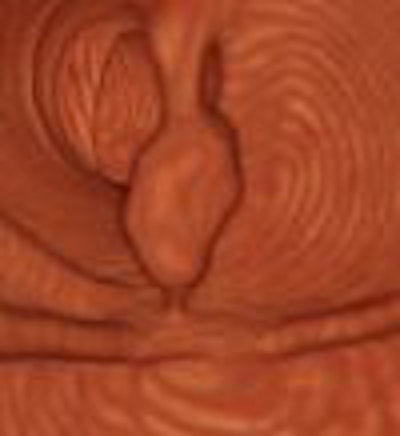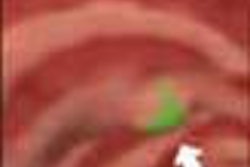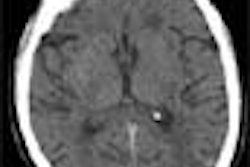

Researchers from New York University’s School of Medicine believe they have come up with a technique for lowering the radiation dose in CT colonography (CTC). By employing a multidetector CT system, the team was able to decrease radiation dose, and achieve faster acquisition times than single-slice CT colonography, for the detection of colorectal polyps.
"When we first started doing virtual colonoscopy on a single-slice CT using a 1-second gantry rotation, 5-mm collimation, a pitch of 2, and 120 kVp and 150 mAs, we ended up with a CT dose index of 6.8 mGy. However, when we used multislice CT with a 0.5-second gantry rotation, a 1-mm collimation, a pitch of 7, and 120 kVp and 50mAs, our CT dose index was 5.7 mGy," said Dr. Michael Macari in a presentation at the 2001 RSNA meeting in Chicago.
Macari’s group performed CTC on 105 patients using a Somatom Plus 4 Volume Zoom multislice scanner (Siemens Medical Solutions, Iselin, NJ). The CT scan was done before the patients underwent traditional colonoscopy. The patient group was made up of 102 men and 3 women, mean age 58. Colonoscopy was performed within 3 hours of CTC on all patients.
"We have a unique opportunity with multislice CT and virtual colonoscopy to decrease the dose because of the very high contrast between insufflated gas and the colon and the wall of the bowel," Macari said.
The group performed both supine and prone CTC following colon insufflation with room air, no glucagon, and the use of either phosphosoda or polyethylene glycol. The CT parameters included a 4 x 1-mm slice collimation, 120 kVp, a 0.5-second gantry rotation, effective mAs of 50, and a variable pitch (6-7) that covered the volume in a 30-second breathold.
"There are some inherent advantages to performing coronal multislice as opposed to single-slice CT for virtual colonoscopy, such as better Z-axis resolution because of the near-isotropic voxels that multislice CT allows," Macari said.
The researchers prospectively interpreted the CTC for the presence, location, size, and morphology of polyps on an offline Vitrea workstation (Vital Images, Minneapolis). The time to interpret the results was also noted. The CT dose index (CTDI) in milliGrays (mGy) was calculated for the technique on the basis of a standard body-phantom model provided by Siemens.
Macari reported that the effective dose for multislice CTC was 2.5 mSv for men and 3.9 mSv for women. The team found that the mean interpretation time for the CTC studies was 12 minutes.
The researchers then compared the CTC and colonoscopy studies for sensitivity and specificity. They found 47 patients without polyps at colonoscopy, and 43 negative via CTC, resulting in a specificity of 92%.
A total of 128 polyps were present in 53 patients at colonoscopy. Of the 128 polyps, CTC detected 11 of 91 (12.1% sensitivity) measuring 5 mm or less, 19 of 27 (70.4 % sensitivity) between 6-9 mm, and 13 of 14 (92.9% sensitivity) polyps that were 10 mm or larger in size. The team considered patients with normal colonoscopies who had filling defects (size 3-6 mm) as CTC false positives.
"With low-dose multislice CT using thin-section CTC, we can achieve near-isotropic voxels, a decrease in the radiation dose, excellent sensitivity, and improved specificity when compared to the single-slice protocol. Hopefully, this will improve both patient and clinician acceptance of virtual colonoscopy," Macari said.
By Jonathan S. BatchelorAuntMinnie.com staff writer
January 10, 2001
Images courtesy of Dr. Michael Macari.
Related Reading
New CAD technique improves CT colonography, December 21, 2002
CT colonography performs very well in five-year study, November 26, 2001
E-Z-EM debuts virtual colonoscopy tagging agent, November 26, 2001
"Virtual colonoscopy" brings comfort to colon cancer surveillance, October 26, 2001
Virtual colonoscopy shows promise as method of colon cancer screening, June 27, 2001
Copyright © 2002 AuntMinnie.com



















